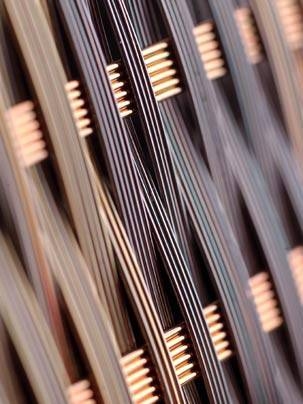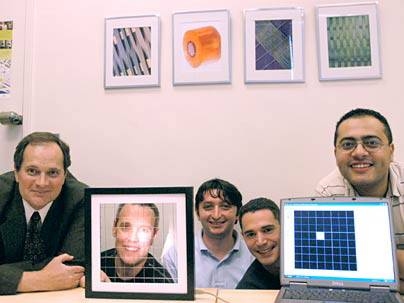In work that could lead to applications such as multifunctional textile fabrics and all-optical computer interfaces, MIT researchers report the creation of flexible fibers and fabrics that can not only sense light, but also analyze its colors.
"These novel fiber structures offer a unique possibility for constructing an optoelectronic functional fabric because the fibers are both flexible and mechanically tough, and can thus be woven," write the researchers in the Oct. 14 issue of Nature. "Interesting device applications follow not only from the ability to engineer the single-fiber properties, but also from the specifics of fiber arrangements into larger assemblies."
The team's leader, Yoel Fink, notes that "the technique we developed allows us to bring together two disparate technologies: those involved in creating optical fibers and those for electronic components."
"This work challenges the traditional barrier between semiconductor devices and fiber-optic processing," said Fink, the Thomas B. King Assistant Professor of Materials Science and Engineering.
Which means the team now is able to create devices that marry the ease of fabrication, length and flexibility of optical fibers with the many integrated functions associated with semiconductor devices.
"Being able, for the first time, to precisely control the behavior of electrons, photons and their interactions within a fiber framework leads naturally to the exciting possibility of eventually creating intrinsically smart fabrics," said co-author John D. Joannopoulos, the Francis Wright Davis Professor of Physics.
Two prototypes
Already the team has created two different prototype fibers with the new technology. The first is a fiber that simultaneously conducts two types of information carriers: electrons and photons. The photons are guided in a hollow core lined by a highly confining reflective surface dubbed "the perfect mirror" when Fink invented it in 1998 as an MIT graduate student. The electrons are conducted through metal microwires that surround the fiber core. The photons and electrons do not interact as they are confined to different spatial locations within the fiber.
The second new fiber utilizes an interaction between photons and electrons. This fiber photodetector was designed to be sensitive to external illumination at specific wavelengths of light. It is made of a cylindrical semiconductor core contacted by four metal microwires that are surrounded by an optical cavity structure. The electrical conductance of this fiber was found to increase dramatically upon illumination with light at the wavelength it was designed to detect.
Some of the most exciting and novel potential applications stem from assembling the fibers into woven structures. As the authors point out, "It is the assembly of such fibers into 2-D grids or webs that enables the identification of the location of an illumination point on a surface," and does so with a very small number of fibers.
Embedding these grids in computer screens or onto projection boards could therefore provide a new type of interface, said Fink. "Instead of having a mechanical mouse, you could just use a light beam, like a laser pointer, to communicate with the computer because the screen would know where it was being hit."
The paper's lead author is Mehmet Bayindir, a postdoctoral associate in MIT's Research Laboratory for Electronics (RLE). Additional authors are RLE postdoctoral associate Ayman Abouraddy, graduate students Fabien Sorin and Jeff Viens of the Department of Materials Science and Engineering, and Shandon Hart (MIT Ph.D. 2004, now at 3M). All of the authors are affiliated with MIT's Center for Materials Science and Engineering and RLE.
This work is funded by the Defense Advanced Research Projects Agency, the Army Research Office, the Office of Naval Research, the Air Force Office of Scientific Research, the Department of Energy, MIT's Institute for Soldier Nanotechnology, and the Materials Research Science and Engineering Center (MRSEC) program of the National Science Foundation.
The researchers included as supplementary material to their publication (archived on Nature's web site) a short video demonstrating a novel optical system developed using the fiber photodetector.
A version of this article appeared in MIT Tech Talk on October 20, 2004 (download PDF).







